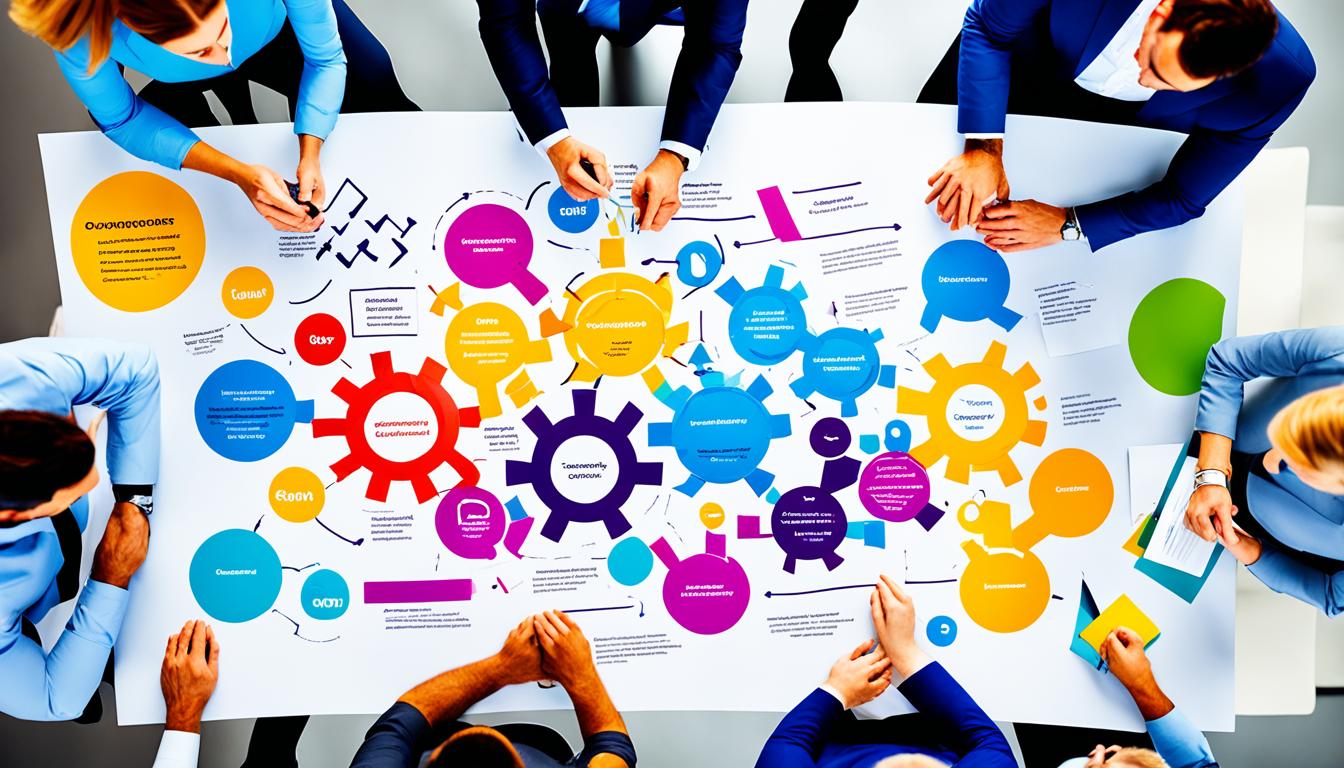In order to understand team dynamics in the workplace and improve productivity, it is important to explore the various theories that explain how teams develop and function. This section will provide an overview of key team dynamics theories in business studies, including Tuckman’s Stages of Group Development, DISC theory, Beckhard’s GRPI model, and Thomas and Kilmann’s model for handling team conflict. By examining these theories, organizations can gain valuable insights on team dynamics, which can lead to more effective collaboration and communication among team members. Tuckman’s model, for example, outlines the stages of forming, storming, norming, and performing, highlighting the critical phases teams go through on their journey to high performance. Similarly, the DISC theory emphasizes understanding individual personality traits, allowing teams to leverage diverse strengths and mitigate potential conflicts for better overall outcomes.
Key Takeaways:
- Tuckman’s Stages of Group Development describe the four stages that teams progress through, highlighting the importance of communication and conflict resolution.
- DISC theory categorizes individuals into four personality traits, aiding conflict management and improving team communication.
- Beckhard’s GRPI model emphasizes clear goals, defined roles, positive relationships, and effective processes for highly effective teamwork.
- Thomas and Kilmann’s model outlines different approaches to managing team conflict, helping teams navigate conflicts and maintain positive dynamics.
- Positive team dynamics contribute to enhanced team performance, improved employee engagement, and higher retention rates.
Tuckman’s Stages of Group Development
Tuckman’s Stages of Group Development, proposed by psychologist Bruce Tuckman, provides valuable insights into team dynamics in the workplace. This model describes the four stages that teams typically progress through: forming, storming, norming, and performing.
Forming: In this initial stage, team members come together, introduce themselves, and start to get acquainted. Communication is often polite and cautious as individuals establish their roles and determine the tasks at hand.
Storming: As the team starts to work together more closely, conflicts and disagreements may arise. This stage is characterized by power struggles, differing opinions, and challenges in establishing leadership. Effective communication and conflict resolution are crucial to successfully navigate this stage.
Norming: In the norming stage, the team begins to establish norms, values, and a sense of cohesion. Roles and responsibilities become clearer, and trust among team members starts to develop. Collaboration and cooperation become more natural, leading to improved team dynamics.
Performing: At this final stage, the team has reached a high level of productivity and effectiveness. The group functions cohesively, leveraging each member’s strengths and working together towards shared goals. Effective communication, problem-solving, and decision-making are hallmarks of this stage.
Understanding Tuckman’s Stages of Group Development can help teams navigate the challenges they may encounter along their journey. By recognizing which stage they are in and implementing strategies to facilitate effective communication and conflict resolution, teams can work together towards optimal performance.
Key Takeaways:
- Tuckman’s Stages of Group Development describes the four stages that teams progress through: forming, storming, norming, and performing.
- Effective communication and conflict resolution are essential for moving past the storming stage.
- The norming stage is characterized by the establishment of norms, values, and trust among team members.
- The performing stage represents a high level of productivity and effectiveness within the team.
By understanding and actively managing these stages, teams can enhance their dynamics in the workplace, leading to improved team effectiveness and ultimately achieving their goals.
DISC Theory
DISC theory, developed by Dr. William Moulton Marston, categorizes individuals into four key personality traits: Dominance, Influence/Inspiring, Steadiness/Supportive, and Compliance/Conscientiousness.
Understanding these personality traits can aid in conflict management and improve team communication. Each trait has its own characteristics, strengths, and weaknesses, which can impact team dynamics and collaboration.
“The DISC theory provides valuable insights into the different ways individuals approach tasks, communicate, and interact within a team,” says Dr. Emily Johnson, a leadership expert. “By understanding and appreciating these differences, teams can harness the unique strengths and perspectives of each member, leading to more effective problem-solving and decision-making.”
Here is an overview of the four DISC personality traits:
| Personality Trait | Characteristics | Strengths | Weaknesses |
|---|---|---|---|
| Dominance | Assertive, results-oriented, direct | Natural leaders, high drive for achievement | May come across as domineering or impatient |
| Influence/Inspiring | Outgoing, persuasive, enthusiastic | Excellent communicators, great at motivating others | May struggle with attention to detail |
| Steadiness/Supportive | Stable, patient, people-oriented | Highly reliable, great team players | May avoid conflict and have difficulty making decisions |
| Compliance/Conscientiousness | Detail-oriented, analytical, cautious | Thorough and accurate in work, good at problem-solving | Can be overly critical or indecisive |
By recognizing and leveraging these distinct traits, teams can improve their communication, adapt their approach to different teammates, and build stronger relationships. The DISC theory provides a framework for understanding individual strengths and challenges, allowing for more effective collaboration and ultimately enhancing team performance.

Beckhard’s GRPI Model
In the realm of organizational behavior theories, Beckhard’s GRPI model stands out as a valuable framework for enhancing team cohesion and overall performance. By focusing on four essential components – Goals, Roles, Interpersonal relationships, and Processes – teams can establish a strong foundation for success.
Goals: The first element of the GRPI model emphasizes the importance of clear and well-defined goals. When team members are aligned on their objectives and have a shared understanding of what needs to be achieved, they can work together more effectively, leveraging their collective strengths and expertise.
Roles: Defining roles and responsibilities is crucial for team success. In the GRPI model, team members have a clear understanding of their individual contributions and how they fit into the larger team structure. This clarity promotes accountability and reduces confusion or duplication of efforts.
Interpersonal relationships: Positive relationships between team members are essential for fostering collaboration and team cohesion. Creating a supportive and inclusive environment enables open communication, trust-building, and the development of strong working relationships that contribute to a cohesive and high-performing team.
Processes: Effective processes streamline team workflows and ensure efficient coordination. The GRPI model encourages teams to assess their existing processes and identify areas for improvement. By implementing streamlined and effective processes, teams can enhance productivity and eliminate unnecessary bottlenecks.
When teams address these four components – Goals, Roles, Interpersonal relationships, and Processes – they lay a solid groundwork for effective collaboration, improved communication, and enhanced overall team performance.
Components of Beckhard’s GRPI Model
| Components | Description |
|---|---|
| Goals | Establishing clear and well-defined objectives |
| Roles | Defining individual responsibilities and contributions |
| Interpersonal relationships | Promoting open communication and building trust |
| Processes | Implementing efficient workflows and coordination |
Thomas and Kilmann’s Model for Handling Team Conflict
In the realm of group dynamics in business, effective conflict management plays a pivotal role in maintaining harmonious team dynamics and driving overall team performance. Thomas and Kilmann’s Model offers valuable insights into different approaches to handle team conflict, enhancing the understanding of team performance factors. This model outlines five main approaches that teams can employ when facing conflicts:
- Competing: This approach involves asserting one’s own interests and goals, without concern for others’ needs. It can be useful in situations requiring quick decisions or when safeguarding important principles.
- Accommodating: This approach prioritizes meeting others’ needs and maintaining relationships, often at the expense of one’s own interests. It can be effective for preserving team harmony and minimizing hostility.
- Compromising: In this approach, team members seek a middle ground by making concessions and finding mutually acceptable solutions. It is appropriate in situations where both parties are willing to compromise and time is of the essence.
- Avoiding: The avoiding approach involves evading or postponing conflicts. It may be suitable when the issue is trivial or when emotions are running high, allowing for temporary relief before addressing the conflict.
- Collaborating: This approach fosters open communication, active listening, and problem-solving to satisfy the needs and interests of all parties involved. It is beneficial when long-term solutions are required and relationships are important.
By understanding and applying the most appropriate approach for a given conflict situation, teams can effectively manage conflicts, promote positive group dynamics in business, and work towards successful resolutions. This model serves as a valuable tool for navigating team dynamics and optimizing team performance.

Importance of Positive Team Dynamics
Positive team dynamics are crucial for enhancing team performance and achieving desirable outcomes. When teams work well together and collaborate effectively, they become more productive and innovative. Positive team dynamics also contribute to improved employee engagement, higher retention rates, and better customer loyalty. By prioritizing and fostering positive team dynamics, organizations can create an environment that supports success and growth.
| Benefits of Positive Team Dynamics |
|---|
| Increased productivity |
| Enhanced innovation and creativity |
| Improved employee engagement |
| Higher retention rates |
| Better customer loyalty |
Positive team dynamics enable teams to work together efficiently and effectively, pooling their skills and resources to achieve shared goals. When team members trust and respect one another, they are more likely to communicate openly, share ideas, and collaborate on solutions. This synergy leads to increased productivity, as team members can leverage each other’s strengths and offset weaknesses.
Moreover, positive team dynamics foster an environment that encourages innovation and creativity. When individuals feel comfortable expressing their ideas and opinions, they are more likely to contribute unique perspectives and think outside the box. This diversity of thought fuels innovation and propels the team towards finding novel solutions and approaches.
Employee engagement is another significant benefit of positive team dynamics. When team members feel valued and supported by their colleagues, they are more likely to be motivated and committed to their work. Engaged employees are more productive, provide better customer service, and are less likely to seek employment elsewhere, leading to higher retention rates for organizations.
Additionally, positive team dynamics have a direct impact on customer loyalty. When teams collaborate effectively, they can deliver exceptional customer experiences, consistently meeting and exceeding expectations. This consistent delivery of value builds trust and rapport with customers, ultimately resulting in greater customer loyalty and advocacy.
By prioritizing and fostering positive team dynamics, organizations can harness the collective power of their teams, enabling them to achieve sustainable success and growth. Investing in team cohesion strategies, such as team-building activities, cross-functional training, and open communication channels, can significantly contribute to building positive team dynamics and reaping the associated benefits.
Key Strategies for Fostering Positive Team Dynamics
- Promote open and transparent communication
- Encourage constructive conflict resolution
- Set clear goals and expectations
- Foster accountability
- Provide leadership development opportunities
By implementing these strategies, leaders can create a supportive and collaborative work environment that empowers teams to perform at their best and achieve exceptional results.
Strategies for Improving Team Dynamics
Effective leaders play a crucial role in influencing team dynamics and creating a positive and collaborative work environment. By implementing various strategies, they can enhance teamwork, improve communication, and drive optimal performance within the team.
Promoting Open and Transparent Communication
Effective communication is essential for improving team dynamics and fostering collaboration. Encouraging team members to share their ideas, concerns, and feedback openly creates an environment of trust and transparency. Leaders can implement regular team meetings, open-door policies, and digital communication channels to facilitate open and honest discussions. This approach promotes better understanding, reduces miscommunication, and helps resolve conflicts efficiently.
Encouraging Constructive Conflict Resolution
Conflict within a team is natural, but managing it constructively is key to maintaining positive team dynamics. Leaders can foster an environment that supports healthy conflict resolution by encouraging team members to express their differences respectfully. By promoting active listening, empathy, and compromise, leaders help team members find common ground and reach mutually beneficial solutions. This approach strengthens relationships, encourages creativity, and enhances team cohesion.
Setting Clear Goals and Expectations
Clear goals and expectations provide a roadmap for team members and enhance their sense of purpose and direction. Leaders should communicate specific, measurable, attainable, relevant, and time-based (SMART) goals to the team. This clarity enables individuals to align their efforts and contributes to a more focused and effective team. Regularly reviewing progress, celebrating achievements, and providing constructive feedback also contribute to improved team performance and motivation.
Fostering Accountability
Accountability is crucial for maintaining high team standards and achieving shared goals. Leaders can foster accountability by defining individual and team responsibilities clearly. Encouraging personal ownership of tasks, setting deadlines, and conducting regular performance reviews help team members stay on track and deliver their best work. By emphasizing the importance of individual and collective accountability, leaders can boost team productivity and effectiveness.
Providing Leadership Development Opportunities
Investing in leadership development benefits both team leaders and the entire team. By providing training, mentoring, and growth opportunities, leaders can enhance their own leadership skills and create a culture of continuous learning within the team. Developing strong leadership capabilities enables leaders to effectively guide and inspire their team members, which in turn improves team dynamics and overall performance.
Incorporating these strategies into team management practices can significantly improve team dynamics, foster collaboration, and enhance overall team effectiveness. When leaders prioritize open communication, constructive conflict resolution, clear goal-setting, accountability, and leadership development, they create a work environment that fosters success, innovation, and high performance.
| Strategies for Improving Team Dynamics | Benefits |
|---|---|
| Promoting Open and Transparent Communication | – Builds trust and transparency – Reduces miscommunication – Facilitates conflict resolution |
| Encouraging Constructive Conflict Resolution | – Fosters healthy team dynamics – Enhances problem-solving skills – Promotes innovation |
| Setting Clear Goals and Expectations | – Provides clarity and direction – Enhances focus and motivation – Improves performance tracking |
| Fostering Accountability | – Maintains high standards – Promotes responsibility – Boosts productivity |
| Providing Leadership Development Opportunities | – Enhances leadership skills – Inspires and motivates team members – Cultivates a culture of learning |
Conclusion
Team dynamics theories in business studies, such as Tuckman’s Stages of Group Development, DISC theory, Beckhard’s GRPI model, and Thomas and Kilmann’s model for handling team conflict, provide valuable insights into how teams develop and function. By understanding these theories and implementing strategies for improving team dynamics, organizations can create a positive and collaborative work environment that fosters success and drives optimal performance.
Understanding the stages of team development, as proposed by Tuckman, enables teams to navigate challenges and enhance communication, ultimately leading to improved productivity. DISC theory helps leaders identify different personality traits within their teams, promoting better understanding and collaboration. Beckhard’s GRPI model emphasizes the importance of clear goals, defined roles, positive relationships, and effective processes for team success.
Thomas and Kilmann’s model offers approaches to managing team conflict, allowing teams to find the best resolution while maintaining positive dynamics. By applying these theories, organizations can create an environment that supports employee engagement, retention, and customer loyalty. Effective leaders can further enhance team dynamics by promoting open communication, constructive conflict resolution, clear expectations, accountability, and leadership development opportunities.
Overall, by integrating team dynamics theories and implementing strategies for improvement, businesses can unlock the full potential of their teams, fostering a culture of collaboration and driving optimal performance for long-term success.
FAQ
What are the key team dynamics theories in business studies?
The key team dynamics theories in business studies include Tuckman’s Stages of Group Development, DISC theory, Beckhard’s GRPI model, and Thomas and Kilmann’s model for handling team conflict.
What are Tuckman’s Stages of Group Development?
Tuckman’s Stages of Group Development describe the four stages that teams may progress through: forming, storming, norming, and performing.
What is DISC theory?
DISC theory categorizes individuals into four key personality traits: Dominance, Influence/Inspiring, Steadiness/Supportive, and Compliance/Conscientiousness.
What is Beckhard’s GRPI Model?
Beckhard’s GRPI model outlines four components of highly effective teamwork: Goals, Roles, Interpersonal relationships, and Processes.
What is Thomas and Kilmann’s Model for Handling Team Conflict?
Thomas and Kilmann’s model outlines five main approaches to managing team conflict: Competing, Accommodating, Compromising, Avoiding, and Collaborating.
Why are positive team dynamics important?
Positive team dynamics contribute to enhanced team performance, improved employee engagement, higher retention rates, and better customer loyalty.
What strategies can be used to improve team dynamics?
Strategies for improving team dynamics include promoting open communication, encouraging constructive conflict resolution, setting clear goals and expectations, fostering accountability, and providing leadership development opportunities.
How do team dynamics theories benefit organizations?
Team dynamics theories provide valuable insights into how teams develop and function, and can be applied to create a positive and collaborative work environment that drives optimal performance. By understanding the stages of team development, leaders can tailor their approaches to meet the evolving needs of their teams. Implementing team dynamics theories in organizations helps in identifying potential conflicts early on and promoting effective communication strategies. Ultimately, these theories not only enhance team cohesion but also foster an atmosphere where creativity and innovation can thrive.


